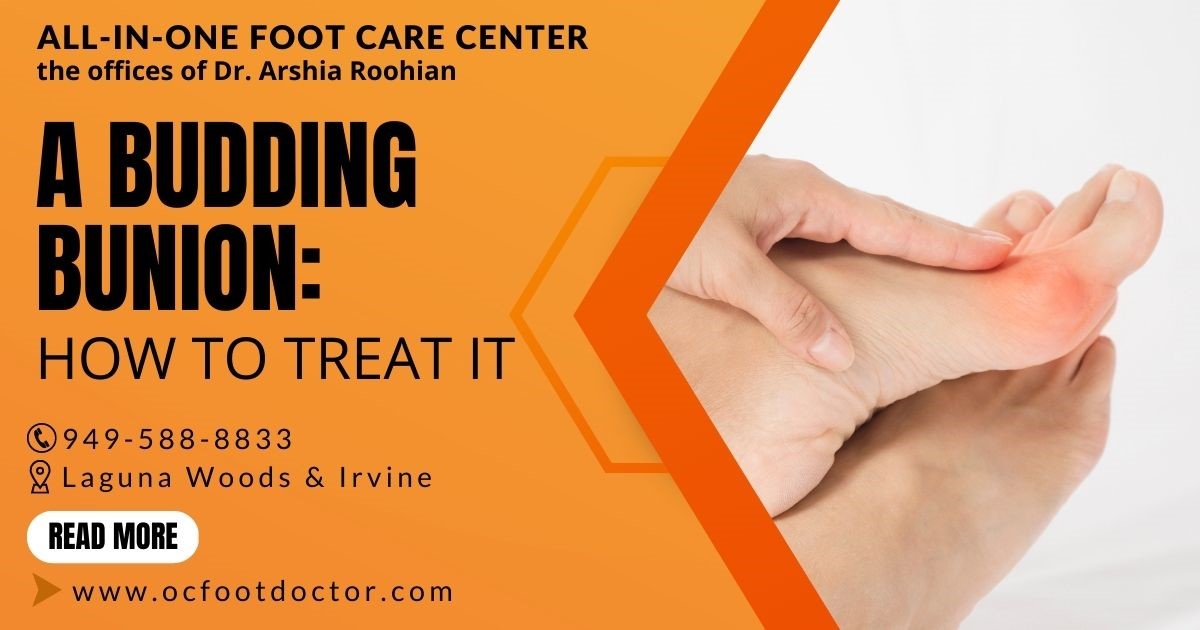A Budding Bunion: How to Treat It

When bunions are neglected, they can adversely affect your quality of life, despite being a relatively minor ailment. While surgery is the only way to eliminate a bunion once it has formed, there are plenty of conservative treatment options to relieve symptoms and prevent the deformity from worsening.
Bunion: What is it?
At the metatarsophalangeal (MTP) joint, a bunion is a painful, bony bump that forms on the base of the big toe. The big toe drifts towards the second toe as a result of excessive pressure on the joint. As time goes on, the bone structure at the joint changes, resulting in a bunion. If left untreated, the deformity will grow steadily, eventually making it difficult to walk and wear shoes.
How do bunions form?
A bunion deformity is caused by three main risk factors:
- Improper Footwear: Toes can often be squeezed together in tight-fitting shoes, especially those with narrow toe boxes. Footwear that displaces weight onto the front of the foot, such as high heels, can also encourage the big toe to shift inward.
- Pre-existing Conditions: Conditions such as Rheumatoid Arthritis and foot injuries can cause problematic stress and inflammation in the MTP joint.
- Genetics: Individuals with certain foot structures and anatomy are predisposed to developing bunions. This is why bunions tend to run in families.
Bunion Treatment: What Can I Do?
A bunion can often be managed without surgery, depending on its severity. It is unlikely that conservative measures will reduce the bunion's size or correct it permanently, but they can alleviate pain and prevent the deformity from worsening. By doing so, your bunion won't restrict your physical activity.
We recommend the following conservative treatment methods:
- Changes in Footwear: Wear comfortable, supportive shoes with a roomy toe box that won't compress your toes.
- Orthotic Devices: Prefabricated and custom-made orthotic inserts can provide additional support for the big toe joint and distribute pressure more evenly as you walk.
- Padding: Cushioning the bunion with non-medicated bunion shield pads is effective in avoiding painful friction. Most pharmacies and drugstores sell these products.
- Physical Therapy: Stabilizing the MTP joint, strengthening muscles and ligaments, and reducing inflammation in the forefoot can be achieved through regular exercise and stretching.
- Pain Relievers: Bunion pain can be relieved with over-the-counter pain relievers and anti-inflammatory ointments. Swelling and discomfort can also be reduced by applying ice or heat. Depending on the severity of the pain, your doctor may prescribe stronger medication or a cortisone injection.
You may need surgery if conservative treatment does not alleviate your bunion's symptoms.
You can contact our office at 949-588-8833, or visit our website at https://www.ocfootdoctor.com. Our offices are in Laguna Hills, Irvine, Mission Viejo, Aliso Viejo, Lake Forest, Foothill Ranch, and Costa Mesa.
📲 949-588-8833
🏢 24331 El Toro Rd, Suite 370 Laguna Woods CA 92637
🏢Irvine Medical Arts Building 113 Waterworks Way, Suite 250 Irvine, CA 92618
🌐 https://www.ocfootdoctor.com/
The information contained above is intended for general reference purposes only. It is not a substitute for professional medical advice or a medical exam. Always seek the advice of your physician or other qualified health professionals before starting any new treatment. Health information on this website MUST NOT be used to diagnose, treat, cure or prevent any disease without the supervision of your doctor.


